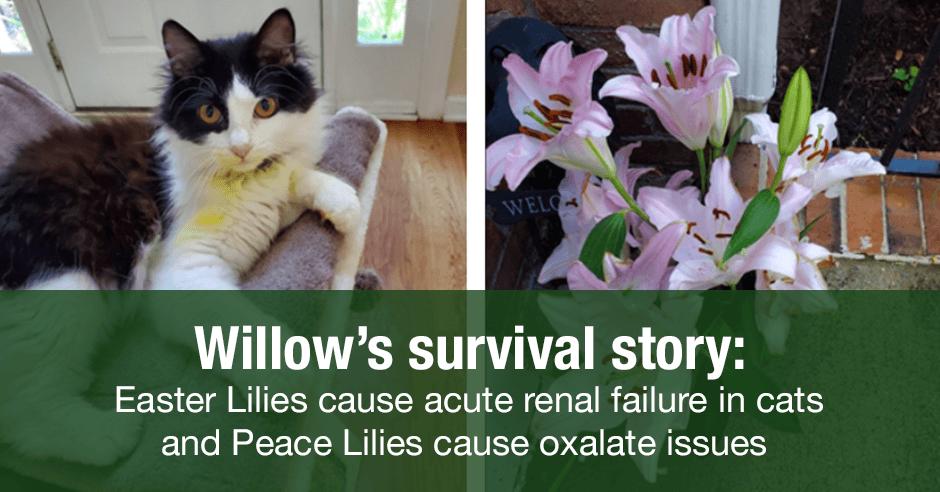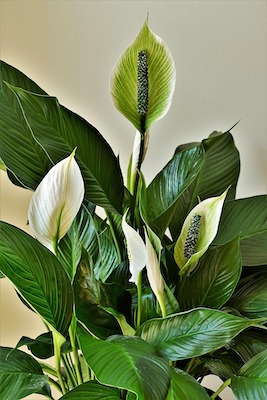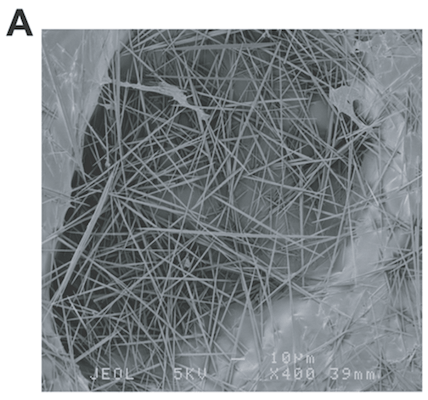
Be aware that Easter Lilies (pictured above) can cause acute renal failure in cats and Peace Lilies (pictured below) can cause calcium oxalate issues.
Lindsey Warnock shared these pictures and the story of her kitty Willow on Facebook and kindly gave me permission to share this on my blog as a caution for anyone with cats:
On Thursday Willow played with lilies in my office. She didn’t eat anything. She only batted at them and got the pollen all over her before I shooed her away. We laughed initially but thank God something in my head told me to google it.
I read, “All parts of the lily – including the stem, leaves, petals, stamens and pollen – are poisonous to cats. Even minor exposures (cat chewing on a leaf or getting pollen on his or her haircoat or whiskers) can be fatal.”
“Cats typically do not survive, even with aggressive therapy (such as dialysis).” [from this site noliliesforcats.com]
I freaked out. Threw her in the shower (that wasn’t fun) and immediately took her up to Blue Pearl Emergency & Specialty Hospital. Due to covid, they came and took her from my car and after her exam the ER doctor called me. She said her prognosis was very poor because they found the pollen around her mouth and on her tongue. She even said, “in my experience I’ve never seen a cat survive lily poisoning. Most owners only realize there’s an issue when the cat is sick and by that point it’s just too late”
Insert hysterical crying here. She said that her only saving grace may be that we sought treatment quickly but realistically she might not make it through the night. They made her throw up, gave her activated charcoal and aggressively treated her with fluid therapy and other meds.
Thank God after 2 days in the hospital, she pulled through!!! We will go for a recheck soon but her doctors are confident her organs didn’t suffer any long term damage from the poisoning.
I can’t tell you the intense guilt I felt and still feel for buying those stupid flowers. I felt like a murderer, terrible fur mom, terrible person. I’ve had cats my entire life and have never heard of lily poisoning. The vet’s response to that was “most people only find out the hard way” The doctors, technicians and staff at Blue Pearl really are the best! They saved our baby.
Please SHARE this with your friends. I would hate to see anyone go through this!! Thank you all for your support during that gut-wrenching 2 days. We’re thankful our girl is back home! No. More. Flowers. Ever.
This was a few weeks ago and when I checked in I see that Willow is still doing well!
This article, Toxic Plants by Tina A Wismer, DVM, DABVT, DABT, shares the toxic effects of the lily (pictured above) Willow brushed up against:
Lilies of the Lilium and Hemerocallis sp.have been shown to cause acute renal failure in the cat. Some examples include: Easter lilies (L. longiflorum), tiger lilies (L. tigrinum), rubrum or Japanese showy lilies (L. speciosum, L. lancifolium), and day lilies (H. species). The toxic principle is unknown, but is known to be water soluble. Even minor exposures (a few bites on a leaf, ingestion of pollen, etc.) may result in toxicosis, so all feline exposures to true lilies should be considered potentially life-threatening and should merit aggressive clinical intervention.
Peace lilies are also an issue for cats and dogs – due to oxalates
Peace Lilies are also harmful for cats and dogs because they contain calcium oxalate crystals. Fortunately they are not deadly.

This Toxic Plants article also lists common houseplants – including Philodendron spp. and Spathiphyllum spp. or Peace Lily – that contain insoluble calcium oxalate crystals, describing how they are also harmful for cats and dogs:
The calcium oxalate crystals look like needles, and when the plant is damaged these crystals embed themselves in the oral cavity. Clinical signs include hypersalivation, vomiting and possible swelling of the pharynx (obstruction is rare). Treatment includes milk or water to rinse mouth. Clinical signs usually resolve within 24 hours with no lasting effects.
Here is an image of calcium oxalate crystals called raphides. You can see why these needle shaped calcium oxalate crystals found can inflict pain and cause harm. There are many different shapes of calcium oxalate crystals and this is just one example.

This article, Easter Lilies and Cats do not Mix! shares more about the two different groups of lilies, “true” lilies (like Easter Lilies) and “benign” lilies (like Peace Lilies). Author, Karen Christopherson, DVM, CVA says “It is best to skip lilies altogether in households where cats live.”
Be sure to read the entire Toxic Plants article for a list of all plants that are harmful and severely toxic to cats and dogs. I had no idea there were so many!
I am not a vet and am not an expert on any of this so please do check in with your own vet.
Oxalate questions I have
With regards to oxalates I have these questions I’d love to know the answers for:
- Do all cats and dogs have an inborn ability to tolerate calcium oxalate crystals like those found in the Peace Lily?
- Would cats and dogs also have issues (especially severe pain in their joints, bladder issues and increased anxiety) if they were to ingest high oxalate foods like spinach, beets, sweet potatoes, soy and kiwi fruit?
- Given that there are some human “antidotes” for helping with acute exposure symptoms after ingestion of high oxalate foods (like spinach, rhubarb, nuts, kiwi fruit etc) in susceptible individuals, I am curious to know if some of these could be used with cats and dogs too: calcium citrate, magnesium citrate, vitamin B6 and/or an epsom salt bath?
- Do humans with dietary oxalate issues have problems working with some of these indoor plants (like Peace Lilies) when planting them, pruning and even getting pollen on the skin?
Are you aware of these harmful effects of plants for cats and dogs? Let us know if you experienced something similar to what happened to Willow or with a plant like the Peace Lily. What advice did your vet share with you and how is your cat or dog doing now?
If you have answers to any of the above questions please do share too.
Feel free to post your questions here too.
We appreciate Lindsey for letting me share this and say well done for your quick thinking!
Read all posts in this series:
- Coronavirus and vitamin C for immune support: new pain or more severe pain due to oxalate issues? (part 1)
- Oxalate crystal disease, dietary oxalates and pain: the research & questions (part 2)
- Vitamin C causes oxalate formation resulting in pain, anxiety, and insomnia (when there is a defect in ascorbic acid or oxalate metabolism)? (part 3)
- Willow’s survival story: Easter Lilies cause acute renal failure in cats and Peace Lilies cause oxalate issues (part 4)
- Waking in the night due to environmental toxins: impacts on the liver, gallbladder and fat digestion (making oxalate issues worse) (part 5)
Another dangerous plant for cats (again, a Liliaceae genus) are grape hyacinths. Their grass-like leaves are a magnet for cats who step outside for a little spring sunshine. I have indoor cats, & 1 likes to make a run for it if he can, when I open the door. He is fast, & heads right for that luscious “grass” which will kill him if he eats it. It seems to be worse for indoor cats that venture out, as they just don’t know what not to eat. Mine wants to taste everything, & I know he needs greens I haven’t been able to provide. He loves early spring catnip & eats it (I bring it in for him) & any leftover is left to dry, & then becomes even more attractive – to be rolled in & eaten dry. I’ve given up house plants, & my 2 are total criminals. They tear off nylon net coverings I’ve tried to secure around them, eat (& maybe knock over as well) then throw up on a rug. I love my cats more than plants, but I do keep some in my sewing room (door is always closed), still with nylon net over them (in case of a break-in).
Connie
Good to know – thanks for sharing
Apologies for the delay in your comment approval and my response. We had a computer glitch where a large number of comments were hidden from view in a spam folder. It mostly affected new folks who were commenting for the first time but it’s hopefully resolved now.
Poor darling Willow and her poor mum, Lindsey! I do feel for her – especially this bit “Insert hysterical crying here.” – I’d have been just the same, crying my eyes out while trying to cope! (I’ve tried this in the past when one of my animals got sick – and found it was actually impossible to focus my eyes for a minute, my tears were coming out so hard. Rescue Remedy or similar can help).
I saw an extremely comprehensive list of plants that are poisonous (in various extents) to cats and dogs on the ASPCA website about 15 years ago – a lot I knew, but there were some I didn’t, it does bear reading – no-one can know everything about everything, after all.
This is their list for cats to avoid https://www.aspca.org/pet-care/animal-poison-control/cats-plant-list
This is their list for dogs to avoid https://www.aspca.org/pet-care/animal-poison-control/dogs-plant-list
This is their list for animals to avoid https://www.aspca.org/pet-care/animal-poison-control/toxic-and-non-toxic-plants/t
I am very relieved that Willow is alright – and kudos to Lindsey for keeping her head and getting Willow help whilst in such distress – and to the animal hospital too!
Hi! I have your book and We have exchanged some comments on here in the past and I have had some success with GABA for neck/shoulder tension per your suggestion. Thank you!!
Here is another problem I have been experiencing and would love some insight from you if I may:)
I am trying to lose some weight- am 45 year old female, have 40 lbs to lose. EVERY SINGLE TIME I try to lower refined sugar, which then restrict carbs and calories somewhaT, I end up feeling more pain. I am talking actual physical pain, like in neck, jaw, shoulders, etc. basically all my “weak areas” where I normally have trouble as well as an overall “pain” inside. I am assuming this is a dopamine/endorphin problem? When people diet, I know they may feel more emotional distress or get grumpy or whatever, but I feel more like I need a “fix” to help ease my body pain. I can only equate it to what addicts must feel like. I inevitably give in and eat something with sugar and can almost feel the “rush” of my “fix”. I feel crazy!!
Just so you know, I am not doing anything crazy like harshly restricting calories Or anything like that. I am trying to just do more of a paleo diet- something that naturally restricts high glycemic, refined sugars etc. this is a huge problem and one that I don’t know how to handle. I keep failing at losing weight- and for health reasons I REALLY need to. And for emotional reasons, I have to find some success!! Please help! Thank you Trudy!!
Mom of 2
Sugar is extremely addicting – this blog may help https://www.everywomanover29.com/blog/the-individual-amino-acids-glutamine-gaba-tryptophan-or-5-htp-dpa-and-tyrosine-are-powerful-for-eliminating-sugar-cravings-often-within-5-minutes/
Really glad to hear GABA has helped with your neck/shoulder tension. Now see if it can also help your sugar cravings